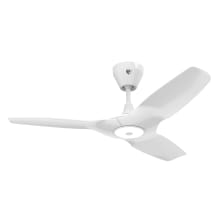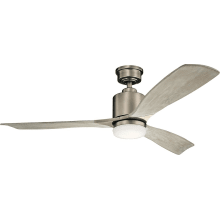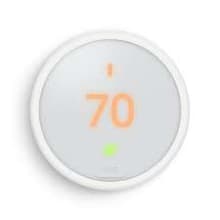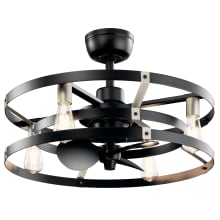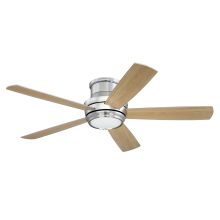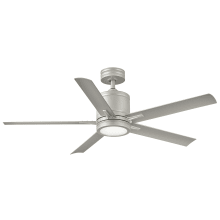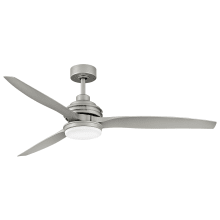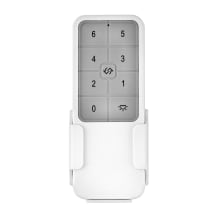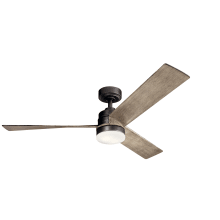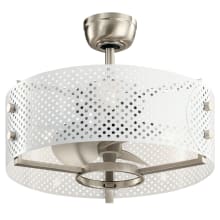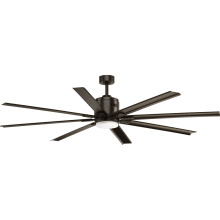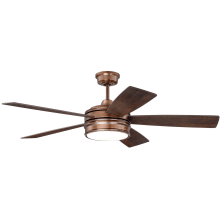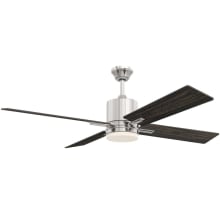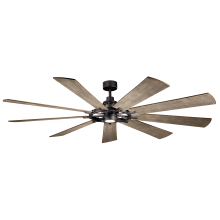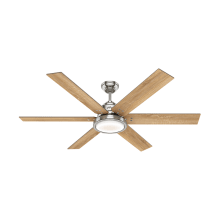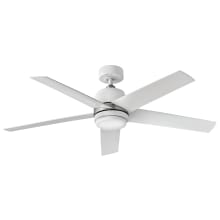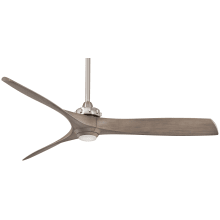The Right Ceiling Fan Direction in Summer and Winter
Don't believe the myths! You can use your ceiling fans in the winter time, too!

In order to keep cool in the summer, it’s obvious: turn on the ceiling fan and circulate the cooler air from the air conditioner or an open window. But in the winter, when you don’t want the cooler air moving around, what should you do? That’s easy! You should switch the ceiling fan direction for wintertime and use the same ceiling fan to move the warmer air around without the fan creating the cooling wind chill effect. Let’s take a look at how to change the ceiling fan direction and get the most out of your ceiling fan year-round.
Does the Ceiling Fan Direction Really Matter?
A fan spinning along the ceiling is a good way to move air. Air movement is an important part of keeping your home cool in the summer and warm in the winter while also keeping your spaces more comfortable in general. Stagnate air gets stuffy and dusty, but a light breeze circulating the air can prevent this. The angle, width, and length of the individual fan blades, as well as the number of blades, can influence how much air is moved at once.
Similarly, the direction of the fan blades determines where the air will move. For instance, a counterclockwise rotation will pull the air up and over the end of the blades, while a clockwise rotation pulls the air up in a more central column directly under the fan. This means that a spinning fan above a desk may not be impacted by the air movement as strongly when it is set clockwise because the air is moving up in a narrower space. When it is set counterclockwise in the summer, it will feel the direct wind chill effect of the focused downdraft.

There’s a simple way to remember which direction ceiling fans should turn in summer or winter: In the summer, you want to cool down, and in the winter, you want to warm up. That means that in the summer, set your ceiling fan to turn counterclockwise to create a downdraft, and in the winter, the ceiling fan direction should turn clockwise to pull the air up.
How to Determine Your Ceiling Fan Direction

The ceiling fan direction switch is often just an on/off toggle switch, with no real indication of which setting it activates. So how do you know which directions the ceiling fan spins? There’s a very simple check to determine the ceiling fan direction, no matter the type or size fan you have.
Simply set the fan to the lowest, slow setting and stand below it, watching it spin. Imagine that you’re looking at a clock face, and the blades are the hands of the clock. If the blades start out on the top left and go down to the right to then spin around back up to the left, the fan is set to spin clockwise for the winter months. If they turn right from the top and spin around towards the left-hand side, then the ceiling fan direction is set counterclockwise for summer temps.
Ceiling Fan Direction in the Summer

Using the ceiling fan during the summer months seems like the obvious choice. It’s important to keep in mind that the ceiling fan direction does make a difference in the summer, even with air conditioning in the home. The ceiling fan can help the air conditioning work more effectively by distributing the colder air more quickly and boosting the impact with the wind chill effect. This can mean the AC doesn’t have to be on for such a long time in order to get the home cool and the ceiling fans circulating cold air.
For cooler air, the ceiling fan direction in the summer should be set to the wider draw of the counterclockwise spin to help move the air to create a wind-chill effect on everything immediately below. This helps keep the air humidity wicked away from the skin, making the room feel cooler. Using ceiling fans helps introduce heavier, cold air to the distributed air, mixing and lessening the effect of the hot air.

Changing the ceiling fan direction to counterclockwise in the summer can help make your AC more effective, or it can reduce the need for the AC entirely on milder days. Either way, a good EnergyStar certified ceiling fan can reduce air conditioning costs by as much as 40%.
How to Use Your Ceiling Fan with the Air Conditioner

Even if your home has central air conditioning, having ceiling fans in every room can help keep the home cooler and your energy costs down. It’s just a matter of knowing how to change the ceiling fan direction for the summer and winter times to use them together most effectively.
To use the fans with central air, switch the ceiling fan direction to counterclockwise to create the most air movement and keep the cooler air circulating quickly and consistently throughout the room. This draws the air away from the exchanges and cools the room more quickly, so the AC won’t have to run quite as long. Once the room is at a comfortable temperature, the ceiling fan direction should keep the colder air moving and feeling cool longer, rather than requiring the air conditioner to keep producing cold air.
The Best Ceiling Fan Direction for the Outdoors

An outdoor ceiling fan is ideal for outdoor patios and porches. The backyard gazebo can be quite comfortable year-round with a ceiling fan creating air movement even in areas protected from the wind. The direct breeze from the ceiling fan can also help keep pests and insects away from the patio while you enjoy it.
Any outdoor ceiling fan’s direction should be set counterclockwise in the summer to generate as much air movement as possible. Use the highest possible speed setting. If you have a heating stove or fire pit, set the outdoor ceiling fan direction clockwise in the winter to help pull the smoke away from seating areas.
Make sure it is an outdoor-rated ceiling fan, as these fans are built specifically for the temperatures and humidity they are exposed to. The fan blades and motor casings of outdoor ceiling fans are better able to withstand the elements and ensure many years of safe use.
Ceiling Fan Direction in the Winter

The common scientific wisdom is that warm air rises because heavier cold air will stay lower to the ground, and your ceiling fan can help mix that up a little. The ceiling fan direction for wintertime should be set to pull the colder air up to mix and warm up those molecules while forcing the warmer air out wider to circulate and redistribute it throughout the room.
Many home heating unit exchanges are located near the floor, so a ceiling fan is a good way to ensure the warmer air is dispersed into the room more effectively by helping to draw the heat upward more quickly. It then sends it out to the rest of the room with the air movement of the fan blades rather than sending the air immediately down in a concentrated area, without the opportunity to create the wind chill effect.
Setting the ceiling fan direction to spin clockwise in the wintertime can pull the lighter, heated air up without a great deal of force and sends it out at a wider spread across the rest of the room. The fan can be set at medium speed to still be effective at moving the heated air around.
Why You Should Use Your Ceiling Fan in Winter
It may seem like wasting extra energy but running the ceiling fan during the winter months can actually be beneficial.
- The fan’s air movement allows the heated air to move and mix while it is still warm.
- A ceiling fan moves heated air into the spaces where people are more likely to feel it.
- Instead of letting the heat settle out into pockets, the fan mixes the air out at the edges of the room and pulls it up to cycle warm air back down.
- Ceiling fans lower the heating bill by more effectively distributing the heated air, especially when paired with an effective thermostat, such as the monitoring of a smart thermostat system.
If you’re concerned about energy use, just make sure to turn the fans off when you leave the room. Ceiling fans don’t change the temperature of the room, only the way the room feels to someone in it, so there’s no reason to run the ceiling fan constantly in an otherwise empty room.
Exceptions to The Rules

Keep in mind that a direct downdraft is a stronger force of the air. It will impact anyone seated immediately under it, either by blowing the air around or by cooling it off. For some ceiling fans, their location may mean that the high-speed, counterclockwise spin can be disruptive. A fan over a home office desk can scatter important papers and mail, and a ceiling fan over the dining room table can cool off a meal before everyone is seated. Not to mention the fact that the wind chill effect can impact people differently, and for some people, it may be too cold.
When the windy counterclockwise airflow doesn’t suit an area, change the ceiling fan direction to run the fan clockwise instead. It will still create the air movement, but it will pull it up and out, away from the area directly under the fan. Changing the ceiling fan direction will circulate the air over a wider area and reduce the impact of the wind chill effect. This trick can be used anywhere, from the dining room and home office to the den or the bedroom.
One of the most often overlooked features about ceiling fans is that they don’t need to be left on when the room is empty. Their greatest advantage is the breeze they create, which is what influences our perception of the temperature in the room. A ceiling fan can be left on in an empty room, and it will still move the air around, prevent it from getting stale, but it doesn’t effectively change the temperature of the room itself. Leaving the fan on in an empty room is mostly a waste of electricity.
Ceiling fans installed along vaulted ceilings can be run counterclockwise year-round. The ceilings are too high up to create much wind chill on anyone at the floor level, and often it’s not easy to safely reach the ceiling fan direction switch to change the ceiling fan direction seasonally. It’s best to set these fans on high speed so that they generate air movement to prevent the hot air from becoming trapped and stagnant. Mixing the warmer air with the cooler air helps keep the elevated ceiling area from overheating in the summer or collecting all the warm air in the winter without sending any of it back down to the living areas.
Another application for this year-round trick is in an indoor or outdoor area where family or guests may occasionally smoke. Using the fan on medium speed while the ceiling fan direction is set to run in a clockwise rotation will pull the smoke away from where people are gathered, moving it up to the ceiling and out toward the walls. (Keep in mind that smoking indoors can lead to buildup on the walls and ceilings over the long term that can cause costly damage, so it is not recommended.) When paired with an exhaust fan or open windows, the ceiling fan can be an effective way to disperse smoke quickly.
Ceiling Fan Direction Switch and Other Features

There are many different brands, manufacturers, and countless designs of ceiling fans to fit virtually anywhere in your home or office. The basics of a ceiling fan will remain similar; however, a ceiling fan will always consist of the motor and housing, the fan blades, and the mounting installation base plate and down rod. Additional styles may include ceiling fans with a light, a remote-control receiver, or a pull switch.
Just below the motor housing on the fan is an additional drop-down housing where the pull switch is installed and where the light kit would be connected to the ceiling fan. This additional housing is called the switch cup because it is where you will find the toggle for the ceiling fan direction switch or the reverse switch, as well as where the pull chain is connected that sets the ceiling fan speed. These are both located below, where the fan blades are connected to the rotors to make them safe and easy to access. The remote-control receiver may be located within the switch cup, or it may be stored above the fan in the mounting bracket, depending on the model design.

Many ceiling fan designs offer reversible fan blades. The fan blades mount to a bracket piece connected to the rotor in the casing, usually by simple screws and nuts, making it easy to swap in replacement ceiling fan blades in case of damage or just a new look. Some designs use different colors or finishes from one side of the fan blade to the other, such as a dark color on one side and a light color on the other. It allows you to customize the look of the fan blades to suit the interior design of your home; for some manufacturer designs, simply buy replacement ceiling fan blades that fit the model in the colors you’re looking for.
Fan blades will come in different shapes, depending on the style of the fan, but they are usually flat. The fan brackets they attach to will set them at a specific angle to help amplify air movement. It’s important not to damage the brackets or bend the angle during installation to make sure the fan blades stay balanced and will not create drag on the motor.
How to Change Ceiling Fan Direction
For most ceiling fans, the easiest way to change the ceiling fan direction is to use the toggle switch on the casing below the fan blades.
How to change ceiling fan direction:
- Set the fan to the Off position. This can be done by pulling the chain, turning the fan off at the wall outlet, or using the smart hub device controls.
- Make certain the blades have stopped completely.
- Using a step stool or ladder, reach up to the switch cup below the fan blades and push the sliding toggle for the ceiling fan direction switch. This reverse switch has only two positions, on or off, but they are often not marked.
And that’s all it takes to change the ceiling fan direction! With only three simple steps required to change the ceiling fan direction, it is easily done any time the temperature in the room needs a little seasonal adjustment.
A Note About Smart Fans
Newer fans may be equipped with smart technology such as energy-saving LED ceiling fans and remote options that control the ceiling fan direction switch as well as the speed and light quality. It just depends on the design. The standard settings will still be a low, medium, and high speed, regardless of the ceiling fan direction or the technology options, and you will still have the option of counterclockwise or clockwise blade spin.
If there’s no reverse switch immediately obvious on your smart fan or remote-controlled fan, look on the remote itself. You will probably find a push-button reverse option on the remote. Some ceiling fans have the reverse option on the wall controls, along with the other setting choices.
Wireless kits and smart switches are available that will allow you to install these options for some fan types, turning a standard ceiling fan into a smart hub compatible device. Make sure you find a kit that offers the exact smart technology advances you’re looking for with your ceiling fan upgrades, such as specific light controls, speed controls, and remote reverse direction switches.
Get the Most Out of Your Ceiling Fans All Year

Whether you have an older ceiling fan or a newer smart fan, it’s relatively easy to change the ceiling fan direction. It can be done seasonally, or it can be switched to meet the temperature or environment in the room at any time. Just remember, to help warm the room up, turn the ceiling fan direction clockwise, and set the ceiling fan direction to counterclockwise for cooling things down.

